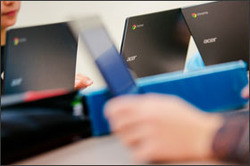Six New Findings on Teacher Ed-Tech Usage
By guest blogger Sidharth Kakkar, co-founder and CEO of Front Row Education, Inc. 
We spend a lot of time thinking about how teachers can effectively implement technology in their classrooms. We also talk to them, and to school leaders, about the impact they’re having on student achievement with these ed-tech tools. Though we’ve collected a lot of anecdotal information about results teachers are getting, we wanted to collect some structured data to get a better sense of the bigger picture. Here’s what we found in a recent survey of nearly 1,000 teachers across the U.S.:
Schools Have Embraced Technology
People who don’t work in education often fail to realize how much has changed in recent years. Many believe the classroom has been untouched over the past 50 years, and while there are some things that have remained constant, the availability of modern tools is a bright spot. Our survey found that the availability of technology for three of every four teachers is “good” or “great.” What’s more, over 40 percent said that there is at least one device for every student in their school, and nearly 90 percent said that they have access to devices daily.
Educators Are Adding to Their Digital Toolboxes
Almost 80% of teachers said their use of technology will be higher this year than last, with this shift being driven by access to devices.
The biggest benefit teachers see from technology is the ability to understand students as individual learners.
When asked to rank how technology has changed how they teach, the number one reasons cited was that technology has helped them determine the skill level of their students more efficiently; seconded by more deeply. The fact that this is the key driver of technology adoption in schools is unsurprising, since this is exactly what teachers try to accomplish in their classroom with or without technology—teaching that reaches every student where they need it.
Software Is Chosen Based on Student Learning
When asked how they pick what software to use, advancing their students’ learning was the top priority, followed by the information that can be provided on student progress. As a mission-driven field, student advancement is key to everything teachers do, which is exhibited clearly in these responses.
Teacher Ed-Tech Usage is Unisex
Only 8.6 percent of male teachers indicated they use technology two or fewer times a week, and only 6.8 percent of female teachers indicated the same. There is no gender bias in terms of how often technology is used.
Age Isn’t a Factor Either
Only 6.9 percent of teachers over 40 indicated they use technology less than twice a week, and 7.31 percent of teachers under 40 indicated the same. There’s often an assumption that a generation of teachers that learned the profession before technology was widely available can’t adapt, and it’s great to see just how false that is.
Ultimately, we think these results exhibit a great deal of positive news. Schools exist to help students learn, and teachers are effectively leveraging technology to help students do just that. Coupled with supportive administration, supportive parents and sufficient funding, education is getting better year after year.
See also:
- District’s Ambitious Personalized Learning Effort Shows Progress
- Adaptive Testing Evolves to Address Common-Core Skills
- Differentiated Instruction: A Primer
- Digital Tools Expand Options for Personalized Learning
- Using Ed-Tech for Personalized, Adaptive, and Differentiated Learning
For more information on Front Row Education Inc., an adaptive, gamified math program for K-8 students, follow @FrontRow on Twitter

And yet the data tells us that tech use in classrtooms is not having a significant effect on most student academic improvement. See "the mountain of" research quoted in Education Week, June 11, 2015, "Why Ed Tech is Not Transforming Teaching", Benjamin Herold.